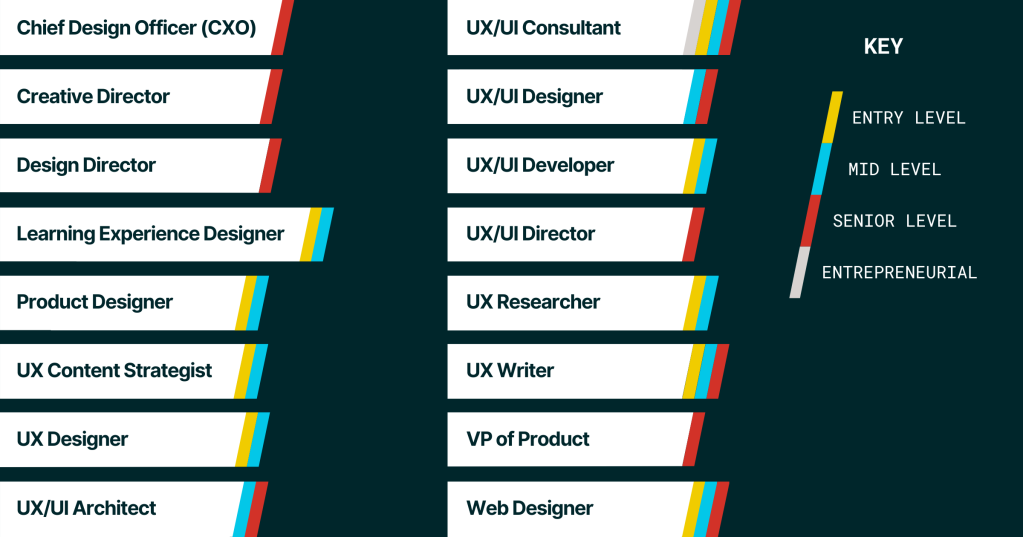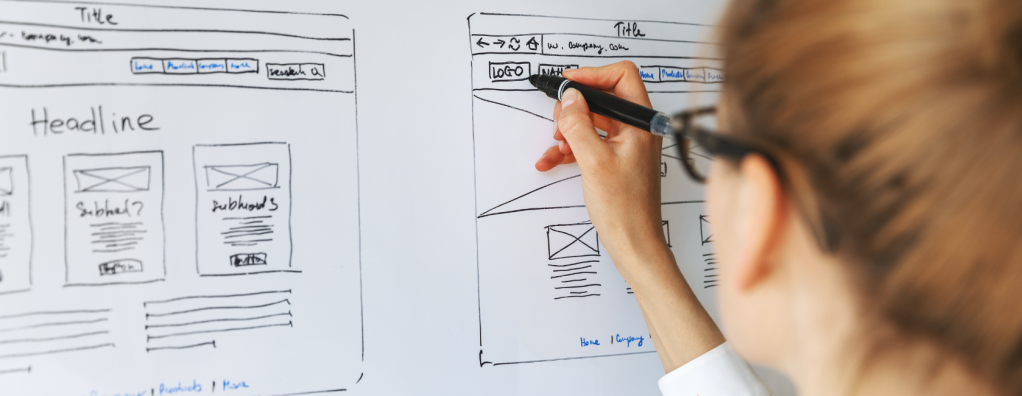The need for creative minds in UX/UI is growing with the use of web and mobile devices. Visuals grab attention while user experience increases retention. The field of UX/UI integrates design, psychology, and business into a comprehensive and multidisciplinary framework. UX designers use research to create personalization along with user feedback. UI designers focus on how a product functions and feels. Anyone with the passion can be successful. Not only is there longevity, but an option to freelance while earning a desirable salary. You have a chance to make a lasting impact in more than one way.
Not convinced yet? Here are a few data points to give you an idea of what the industry has to offer and where it’s heading.

Let’s review this skill set together by discussing how UX/UI expertise can be acquired, applied, and transformed into a fulfilling career.
What can I do with UX/UI skills?
With UX/UI skills, you can pursue a variety of rewarding career paths. You can work as a UX designer, creating user-friendly interfaces and optimizing user experiences for websites and applications. Alternatively, you can become a UI designer, focusing on the visual elements and aesthetics of digital products. You might also explore roles such as interaction designer, usability analyst, and product designer, all of which rely on strong UX/UI expertise to enhance user satisfaction and product effectiveness. These skills are highly sought after in the tech industry and offer opportunities for both full-time employment and freelance work.
UX/UI professionals typically have the following responsibilities:
- User research
- Visual storytelling and prototyping
- Information architecture
- User interface design
- Usability testing
- Accessibility considerations
Listen as Assistant Vice President and UI Designer of Synchrony, Iuliia Bakhtoiarova, shares what a work day may look like utilizing her UX/UI skills.

It depends on the day. Sometimes, you design. You take UX research and you create mockups based on the results that we acquired through the testing. And then the mockups and prototypes, we add animations to those screens and it’s not one day, it’s a whole process. You can do bits and pieces of the process on any given day. At the same time, you work closely with the agile team. There are some calls with agile teams to understand what they’re working on. If they are working on any UX items, we have to be involved to make sure that the developers build out our UI interfaces according to mock ups. So we are also guarantors of good UI in a production.
Discover your career opportunities
There are diverse job titles within the UX/UI industry. Below are a few examples to consider:

Expert advice
“When pursuing UX/UI opportunities, think of your portfolio as a canvas for your creativity. Fill it with projects that not only showcase your design skills but also your ability to think outside the box. Consider working on side projects that reflect your personal interests and unique design concepts. During interviews, tell the story of your design journey — share the challenges you’ve faced and the creative solutions you’ve crafted. Show that your passion for creativity goes beyond the workplace and that you’re always eager to learn and innovate.”
– Irene Tirella, career expert at edX

How can I acquire UX/UI skills and turn them into a career?
If you’re interested in pursuing your own career in UX/UI, we recommend taking these steps:
Research is key when it comes to any career, and a career in UX/UI is certainly no exception. Take advantage of all the information out there, whether through browsing the internet for job titles, listening to tech-relevant podcasts, or getting connected to professionals in the areas or positions that interest you.
Pro tip:
Explore your career possibilities. As part of your research, take every opportunity to learn more about topics in your desired field. Browse the edX course catalog at edx.org to see what UX/UI-related topics, courses, and programs interest you, and start building your UX/UI skills today.
One key part of the research phase is networking. This simple step is often overlooked and undervalued but can significantly impact your career trajectory. To clarify your career goals and aspirations, you must talk with professionals about what the work looks like.
You open a door of opportunity in your career by reaching out to professionals in your targeted fields, positions, and companies. Connecting with UX/UI professionals who could vouch for you and provide hard-to-find intel about the industries or organizations of interest is invaluable.
Pro tip:
We highly recommend scheduling informational interviews to learn from and connect with UX/UI professionals and hiring managers to gather information. These contacts can help you learn new skills, offer advice, and share job opportunities.
Check out our Networking Guide and Outreach Templates and Resources for help getting started.
To supplement your understanding of what others are doing professionally, gain clarity on your own goals and aspirations. Ask yourself what about UX/UI interests you — the possibilities are endless.
Your career goals may require skills in user research, wireframing, prototyping, visual design, and usability testing. Transferable skills such as problem-solving, effective communication, and project management can greatly enhance your ability in the field of UX/UI design. Here is a compilation of UX/UI competencies and adaptable skills:
UX/UI skills
- Agile methodologies and processes
- Basic marketing concepts
- Product management
- User-centric design research
- Visual prototyping and wireframing
- User interface deployment
- Web prototyping and development
Transferable skills
- Adaptability
- Creativity
- Curiosity
- Empathy
- Organization
- Attention to detail
- Problem-solving
- Strong communication
- Strong business acumen
- Strong presenter, collaborator, storyteller
Pro tip:
To gain a deeper understanding of which skills you may need to achieve your career goals, we recommend exploring job postings. Take note of the technologies and skills that are commonly included in job posts that interest you. These are likely the skills that you need to acquire.
When it comes to acquiring UX/UI skills, you have numerous options. We recommend selecting a path that aligns best with your needs and learning style. Here are a few options to consider:
Self-education — If you want to learn asynchronously, informally, or casually, self-education is a great place to start. There are many approaches to this method that support various career goals, budgets, learning preferences, and time commitments. Here are some ways to self-educate:
- Informal opportunities: Explore books, articles, and even research papers to expand your UX/UI knowledge and learn what’s happening in the field. Not a reader? Plenty of videos, podcasts, and other forms of multimedia that can teach you a thing or two about UX/UI.
- Online courses: If you prefer a more structured or socialized learning experience, online courses might be a good option. edX.org offers several instructor-led and self-paced courses.
- Professional certifications: When you want a less casual learning experience but don’t have needs that warrant a boot camp, professional certifications may be the best fit for you. Professional certifications are a great addition to your resume and prove your technical skills for roles in UX/UI. edX.org offers many certificate programs that may interest you.
Boot camps — Experienced curriculum teams design these innovative programs to help you achieve your career goals in a fraction of the time it takes to complete a traditional degree. With many boot camps lasting just 3-12 months, you’ll be amazed at how quickly you can gain the knowledge and expertise you need to launch your dream career. Explore popular UX/UI boot camps on edX.org.
Building a UX/UI portfolio is vital to demonstrate your design skills and practical experience, setting you apart from the competition. It establishes credibility and showcases your unique approach and problem-solving abilities. Also, it builds trust with potential employers or clients and serves as a conversation starter during interviews. Today, it is an essential tool for career advancement.
Here are some pointers for constructing an outstanding UX/UI portfolio:
Highlight your skills — Customize your portfolio to demonstrate your UX/UI skills, such as your proficiency in user research, visual design, and usability testing.
Showcase your experience — Showcase your projects, including the ones you’ve worked on, or highlight your practical experience. Illustrate how you’ve successfully applied your UX/UI skills in real-world scenarios.
Use storytelling to support your design work — Narrate the design journey, explaining your design process, decision-making rationale, and how you’ve addressed specific design challenges. This provides insight into your mindset and approach.
Helpful resources:
The career team at edX has resources and workshops to help you fine-tune your application materials and prepare for interviews. Start with the Behavioral Interview Prep Guide and UX/UI portfolio guide to help you prepare for interviews and develop your unique UX/UI narrative.
Once you achieve your UX/UI career goal, celebrate your success. The career journey is full of ups and downs, and every victory deserves acknowledgment.
Your journey doesn’t end here — it’s only just beginning. Give yourself grace and understand that careers are not linear. Here are some ways you could continue growing your UX/UI skills:
Continuous learning — Make it a habit to explore our extensive course catalog on edX.org for ongoing educational opportunities. Now that you’ve taken the first steps in your career, there’s always value in refreshing your skills, deepening your industry knowledge, or delving into related subjects that can enrich your work or align with your interests.
Advancement — Advancing in your UX/UI career can vary significantly depending on the industry, role, and function. You may find yourself progressing to the role of a UX designer, or you might even consider venturing into entrepreneurship by establishing your own creative agency.
Promotions in UX/UI:
Here are a few senior roles you may want to pursue as you advance your career in UX/UI:
Director of user experience (UX): Oversees all aspects of the user experience within an organization, leading and managing a team of UX/UI designers, researchers, and other professionals. Defines the UX strategy, sets design standards and guidelines, aligns UX goals with business objectives, and ensures a cohesive and user-centered approach across all products and services.
Principal UX designer: Responsible for leading complex design projects, provides mentorship and guidance to junior team members, and makes high-level design decisions. Possesses a deep understanding of user-centered design principles, conducts advanced user research, and creates innovative design solutions that address intricate user needs.
UX research director: Specializes in user research and leads the research function within an organization. Oversees a team of UX researchers and strategizes on research methodologies to gain valuable insights into user behavior and preferences. Defines research goals, manages budgets and resources, and collaborates with UX/UI designers to translate findings into actionable design improvements.
VP of product design: Responsible for shaping the overall product design vision, aligning it with the company’s strategic objectives. Oversees multiple design teams and collaborates with product managers and engineers.
Chief experience officer (CXO): Responsible for the overall experience that customers have with the company’s products and services, shaping the user experience strategy. Focuses on creating a cohesive and positive customer journey, centered on consistency, quality, and customer satisfaction across all touchpoints.
Career shifts — Periodically assess your contentment with your daily responsibilities. If you discover that your current role doesn’t satisfy you, take the time to analyze what aspects you enjoy and what you find less appealing. Keep an eye out for growth opportunities within your organization and be open to pursuing career shifts that leverage your background, skill set, and passions.
Remember, your career is a dynamic and evolving journey, and embracing change and continuous learning will be instrumental in your long-term success in UX/UI.
What could my career look like with a UX/UI skill set?
It’s difficult to say exactly what your life would look like with a UX/UI skill set, but we can provide some insight. Consider how these may factor into your life plan:
High demand for skills — There will be an estimated 19,000 job openings for digital designers over the next 10 years, according to the U.S. Bureau of Labor Statistics (2023). The ongoing trend of using mobile devices is expected to generate a need for more UX/UI designers.
Lucrative career — Roles in UX/UI can be financially rewarding. UX/UI designers frequently earn substantial salaries that are highly competitive within the industry. Senior roles in the field can offer substantial income potential.
Diverse work environments — UX/UI professionals have the flexibility to work in diverse settings, including tech companies, design agencies, startups, and even as freelancers. This allows for varied work experiences and potential for remote work.
Influence on user-centric design — UX/UI designers play a pivotal role in shaping the user experience of digital products. Their work directly impacts how users interact with technology, making it a field with the potential to influence and improve people’s daily lives.
Continuous learning opportunities — With evolving design trends, tools, and technologies, learners with UX/UI skills can expect continuous opportunities for learning and staying up-to-date with industry advancements, fostering personal and professional growth.
Expert advice
“I’m going to give an overview: it’s strategize, plan, create, proof, revise, edit, deploy, analyze, optimize, repeat. Whatever stage of marketing [you’re in], whatever your tier is within an organization, whether you’re entry level or VP, those are the components of marketing. And that’s how you start from beginning to end. You do that for every channel and for every touch point that you have with your customers.”
– Danielle B., lead UX product designer at Webserv

What are my next steps?
Learn more about UX/UI:
Register for a course on edX to learn about a variety of topics within the field of UX/UI, such as “UX Prototyping,” “Human-Computer Interaction for User Experience Design,” and “Intro to Design Thinking.”
Watch a session
Watch a relevant session on our Events page to learn more about the industry and other professionals’ experiences within it.










